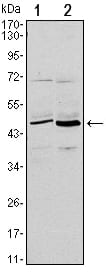
| WB | 1/500-1/3000 | Human,Mouse,Rat |
| IF | 咨询技术 | Human,Mouse,Rat |
| IHC | 咨询技术 | Human,Mouse,Rat |
| ICC | 技术咨询 | Human,Mouse,Rat |
| FCM | 咨询技术 | Human,Mouse,Rat |
| Elisa | 咨询技术 | Human,Mouse,Rat |
| Aliases | B70; B7-2; LAB72; CD28LG2; MGC34413; CD86 |
| Entrez GeneID | 942 |
| clone | 1B3 |
| WB Predicted band size | 52kDa |
| Host/Isotype | Mouse IgG1 |
| Antibody Type | Primary antibody |
| Storage | Store at 4°C short term. Aliquot and store at -20°C long term. Avoid freeze/thaw cycles. |
| Species Reactivity | Human |
| Immunogen | Purified recombinant fragment of human CD86 expressed in E. Coli. |
| Formulation | Ascitic fluid containing 0.03% sodium azide. |
+ +
以下是关于TP53INP1抗体的3篇参考文献及其摘要概括:
---
1. **文献名称**:*TP53INP1 is a novel p53 target gene regulating autophagy and apoptosis*
**作者**:Tomasini R. et al.
**摘要**:该研究利用TP53INP1特异性抗体,通过免疫印迹和免疫荧光技术验证了其在细胞内的表达与定位。结果显示,TP53INP1受p53调控,通过激活自噬和凋亡通路增强肿瘤抑制功能,尤其在氧化应激条件下作用显著。
---
2. **文献名称**:*Oxidative stress triggers TP53INP1 nuclear translocation and enhances its tumor suppressor activity*
**作者**:Seillier M. et al.
**摘要**:研究采用抗TP53INP1抗体进行亚细胞定位分析,发现氧化应激(如H₂O₂处理)诱导TP53INP1向细胞核聚集,并促进p53依赖的凋亡通路。抗体在染色质免疫沉淀(ChIP)中的应用进一步证实其与DNA损伤修复基因的相互作用。
---
3. **文献名称**:*Downregulation of TP53INP1 correlates with poor prognosis in pancreatic cancer*
**作者**:Gironella M. et al.
**摘要**:通过免疫组化(IHC)结合TP53INP1抗体,分析胰腺癌组织样本发现,TP53INP1低表达与患者生存期缩短及肿瘤侵袭性增强相关。研究提示其作为预后生物标志物的潜在价值。
---
以上文献均通过TP53INP1抗体开展蛋白表达、定位及功能研究,聚焦于其在肿瘤抑制、应激反应及临床预后中的作用。如需具体期刊信息或DOI,可进一步补充关键词检索。
The TP53INP1 (Tumor Protein p53 Inducible Nuclear Protein 1) antibody is a critical tool for studying the role of TP53INP1. a stress-induced protein regulated by the tumor suppressor p53. TP53INP1 functions as a pro-apoptotic protein, contributing to cellular responses to oxidative stress, DNA damage, and autophagy. It exists in two isoforms, TP53INP1α and TP53INP1β, which localize to the nucleus and cytoplasm, respectively, modulating p53 activity and enhancing its tumor-suppressive functions. Dysregulation of TP53INP1 is implicated in cancer progression, with reduced expression observed in various malignancies, including pancreatic, breast, and liver cancers, correlating with poor prognosis and therapeutic resistance.
Antibodies targeting TP53INP1 are widely used in research to investigate its expression patterns, subcellular localization, and interactions with p53 and other partners. These antibodies enable techniques such as Western blotting, immunohistochemistry (IHC), and immunofluorescence (IF) to assess TP53INP1 levels in cell lines, tissues, or patient samples. Validation of TP53INP1 antibodies often involves knockdown/knockout controls to confirm specificity. Research using these antibodies has highlighted TP53INP1's dual role in promoting apoptosis and autophagy, as well as its potential as a biomarker for cancer susceptibility or treatment response. Ongoing studies aim to explore TP53INP1's therapeutic relevance, particularly in restoring its expression to counteract tumor growth or chemoresistance.
×